

MATTHEW 27:32-66
[Editor's note: This lecture utilized slides about the "Shroud of Turin" to assist the audience in better understanding the crucifixion of Christ. It should not be implied that the lecturer or anyone else in the church of Christ accepts that the Shroud was the actual burial cloth of Jesus Christ.]
If you're squeamish, you may want to sit by the door.
Today we will look at some slides to get our mind focused on the magnitude of this lesson. There will be readings from all four gospels - with explanations of the slides thrown in. We will cover the seven sayings of Jesus while on the cross. Feel free to interrupt or ask to back up.



"Then Pilate took Jesus and had Him flogged" - or scourged.
"Flagellum taxillatum" - thonged whip - for slaves, rebels - for non-citizens of Rome.
Psalms 129:2-3, "Many a time they have afflicted me from my youth . . . The plowers plowed on my back; They made their furrows long."
 "Then the governor's soldiers took Jesus into the Praetorium and gathered the whole company of soldiers around Him. They stripped Him and put a scarlet robe on Him, and then twisted together a crown of thorns and set it on His head. They put a staff in His right hand and knelt in front of Him and mocked Him. 'Hail, king of the Jews!', they said. They spat on Him, and took the staff and struck Him on the head again and again." (Matthew 27:27-30; John 19:1-3.)
"Then the governor's soldiers took Jesus into the Praetorium and gathered the whole company of soldiers around Him. They stripped Him and put a scarlet robe on Him, and then twisted together a crown of thorns and set it on His head. They put a staff in His right hand and knelt in front of Him and mocked Him. 'Hail, king of the Jews!', they said. They spat on Him, and took the staff and struck Him on the head again and again." (Matthew 27:27-30; John 19:1-3.)
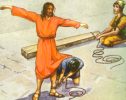
"And when they had mocked Him, they took off the purple robe and put His own clothes on Him. Then they led Him out to crucify Him. (Mark 15:20.)
Crucifixions could be done in more than one way. There was no wrong way. The method used was left to the whim of the executioner. All the executioner had to know was (if the criminal were to be nailed) where to place the nails--between what bones--so the body could be held up without the weight of the body tearing through the skin. Some were crucified with the knees bent totally under the body; some had platform for sitting - prolonged life and agony; some were only tied onto a cross; some were nailed, but supported by ropes.
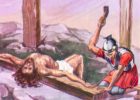

We know from John 20:24 (Jesus with "doubting Thomas") and from Colossians 2:14 that Jesus was actually nailed to the cross.
For the hands, the nail went through what we would call the wrist. Damage to the median nerve causes shooting pains - draws thumb in toward palm - leaves three digits paralyzed.
If the nail were placed in the palm of the hand, the skin would rip out within 10 minutes. The executioner would have to start all over again.
A victim of crucifixion experiences a lowering of blood pressure, acceleration of pulse, insufficient circulation in the heart, fainting spells.
Consider how large one of these nails would be.

In the foot.
Through both feet where the whole weight of the body could rest on these bones
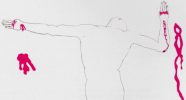 while the condemned man pushed himself up to be able to exhale. At first the crucified would be able to inhale and exhale in either position, but soon the muscles would tire of pushing the air out from the slumped position. He would resort to up and down positions - shifting weight between hands and feet.
while the condemned man pushed himself up to be able to exhale. At first the crucified would be able to inhale and exhale in either position, but soon the muscles would tire of pushing the air out from the slumped position. He would resort to up and down positions - shifting weight between hands and feet.
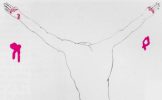
After he couldn't stand the weight on the feet anymore, He would let himself down back onto the weight of His hands. Instinctive attempt at self-preservation. "See-Saw motion." Two tracks of blood from the same wounds at different angles.
 "When they came to the place called the Skull, there they crucified Him, along with the criminals ... Jesus said, 'Father, forgive them, for they do not know what they are doing'." (Luke 23:32-34.)
"When they came to the place called the Skull, there they crucified Him, along with the criminals ... Jesus said, 'Father, forgive them, for they do not know what they are doing'." (Luke 23:32-34.)
 "Pilate had a notice prepared and fastened to the cross. It read: JESUS OF NAZARETH, THE KING OF THE JEWS. Many Jews read this sign, for the place where Jesus was crucified was near the city, and the sign was written in Aramaic, Latin and Greek. The chief priests of the Jews protested to Pilate, 'Do not write, "The king of the Jews," but that this man claimed to be king of the Jews.' Pilate answered, 'What I have written, I have written'." (John 19:19-22.)
"Pilate had a notice prepared and fastened to the cross. It read: JESUS OF NAZARETH, THE KING OF THE JEWS. Many Jews read this sign, for the place where Jesus was crucified was near the city, and the sign was written in Aramaic, Latin and Greek. The chief priests of the Jews protested to Pilate, 'Do not write, "The king of the Jews," but that this man claimed to be king of the Jews.' Pilate answered, 'What I have written, I have written'." (John 19:19-22.)
"One of the criminals who hung there hurled insults at Him: 'Aren't you the Christ? Save yourself and us!' But the other criminal rebuked him. 'Don't you fear God,' he said, 'since you are under the same sentence? We are punished justly, for we are getting what our deeds deserve. But this man has done nothing wrong.' Then he said, 'Jesus, remember me when you come into your kingdom.' Jesus answered him, 'I tell you the truth, today you will be with me in paradise.'" (Luke 23:39-43.)
"Near the cross of Jesus stood His mother, His mother's sister, Mary the wife of Clopas, and Mary Magdalene. When Jesus saw His mother there, and the disciple whom He loved standing nearby, He said to His mother, 'Dear woman, here is your son,' and to the disciple, 'Here is your mother'." (John 19:25-27.)
Keep in mind that at first it would be difficult to speak, but could be done. He had to be pushing up on His feet. As the muscles grew weaker and the wounds more agonizing, so would the voice and ability to speak become more difficult.
"From the sixth hour until the ninth hour darkness came over all the land. About the ninth hour Jesus cried out in a loud voice, 'ELOI, ELOI, LAMA SABACHTHANI?'- which means, 'My God, my God, why have you forsaken me?" (Matthew 27:45-47; Psalm 22:1.)
"Later, knowing that all was now completed, and so that the Scripture would be fulfilled, Jesus said, 'I am thirsty.' Immediately one of them ran and got a sponge. He filled it with wine vinegar, put it on a stick, and offered it to Jesus to drink." (John 19:28,29; Matthew 27:48-49.)
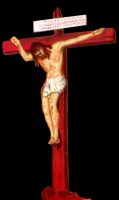 "When He had received the drink, Jesus said, 'It is finished'." (John 19:30) In the Greek this would be a one word shout, 'TETELESTAI' (also in Aramaic). This is the victor's shout or the shout of a man who at last has completed his task, the cry of the one who has won through the struggle, one who has truly captured the victor's crown.
"When He had received the drink, Jesus said, 'It is finished'." (John 19:30) In the Greek this would be a one word shout, 'TETELESTAI' (also in Aramaic). This is the victor's shout or the shout of a man who at last has completed his task, the cry of the one who has won through the struggle, one who has truly captured the victor's crown.
"Jesus called out with a loud voice, 'Father, into your hands I commit my spirit.' With that, He bowed His head and gave up His spirit." (Luke 23:46, John 19:30.)
"Now it was the day of Preparation, and the next day was to be a special Sabbath. Because the Jews did not want the bodies left on the crosses during the Sabbath, they asked Pilate to have the legs broken and the bodies taken down. The soldiers therefore came and broke the legs of the first man who had been crucified with Jesus, and then those of the other. But when they came to Jesus and found that he was already dead, they did not break His legs."
The scourging and the manner of crucifixion hastened His death. If the others weren't scourged as thoroughly or the executioner used a different style of crucifixion, they could live longer.
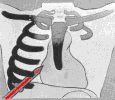 "Instead, one of the soldiers pierced Jesus' side with a spear, bringing a sudden flow of blood and water ... These things happened so that the scripture would be fulfilled: 'Not one of His bones will be broken,' and, as another scripture says, 'They will look on the One they have pierced.'" (John 19:31-37.)
"Instead, one of the soldiers pierced Jesus' side with a spear, bringing a sudden flow of blood and water ... These things happened so that the scripture would be fulfilled: 'Not one of His bones will be broken,' and, as another scripture says, 'They will look on the One they have pierced.'" (John 19:31-37.)
"It was Preparation Day ... So as evening approached, Joseph of Arimathea, a prominent member of the Council, who was himself waiting for the kingdom of God, went boldly to Pilate and asked for Jesus' body ...
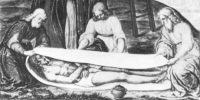 With, Pilate's permission, he came and took the body away. He was accompanied by Nicodemus, the man who earlier had visited Jesus at night. Nicodemus brought a mixture of myrrh and aloes, about 75 pounds. Taking Jesus' body, the two of them wrapped it, with the spices, in strips of linen. This was in accordance with Jewish burial customs." (John 19:38-42.) "Joseph took the body, wrapped it in a clean linen cloth
With, Pilate's permission, he came and took the body away. He was accompanied by Nicodemus, the man who earlier had visited Jesus at night. Nicodemus brought a mixture of myrrh and aloes, about 75 pounds. Taking Jesus' body, the two of them wrapped it, with the spices, in strips of linen. This was in accordance with Jewish burial customs." (John 19:38-42.) "Joseph took the body, wrapped it in a clean linen cloth
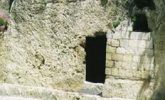 and placed it in his own new tomb that he had cut out of the rock. Because it was the Jewish day of Preparation and since the tomb was nearby, they laid Jesus there. He rolled a big stone in front of the entrance to the tomb and went away." (Matthew 27:59,60; John 19:38-42.)
and placed it in his own new tomb that he had cut out of the rock. Because it was the Jewish day of Preparation and since the tomb was nearby, they laid Jesus there. He rolled a big stone in front of the entrance to the tomb and went away." (Matthew 27:59,60; John 19:38-42.)
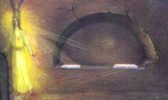 Next week we will study what happened on Sunday morning.
Next week we will study what happened on Sunday morning.
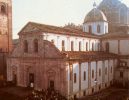

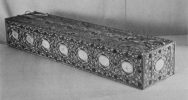

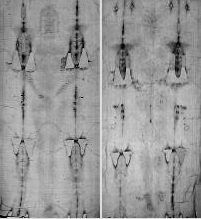 | Here you can see both the front and back images side by side. Note: the image of the face, the left foot and hand over the right, wound on the right ribs ... |
 Around the turn of the century a man was
Around the turn of the century a man was
 allowed to photograph the Shroud of Turin for the first time.
As he was developing the negative, he was astonished to find a much clearer image than the cloth itself contained.
The cloth was discovered to be the negative and he was looking at the positive "print."
allowed to photograph the Shroud of Turin for the first time.
As he was developing the negative, he was astonished to find a much clearer image than the cloth itself contained.
The cloth was discovered to be the negative and he was looking at the positive "print."
Could actually see the features of the face, the left foot over the right, busted knee caps perhaps from falling. And on the back ...
 about 80 to 200 bloody scourge marks were readily apparent.
about 80 to 200 bloody scourge marks were readily apparent.
The features of the face - bruised and swollen cheeks, perhaps from falling or from being beaten, blood coming from cuts on the head, broken nose, etc. ...




Jeannie Cole
West-Ark Church of Christ, Fort Smith, AR
Ladies Bible Class, Spring 1991




![]() Link to Jeannie's other Ladies' Bible Class lectures
Link to Jeannie's other Ladies' Bible Class lectures
 Link to Jeannie Cole Home Page
Link to Jeannie Cole Home Page

West-Ark Church of Christ